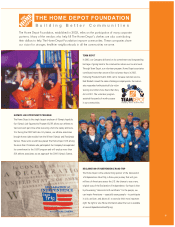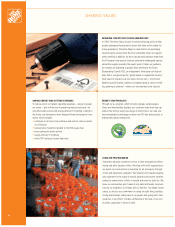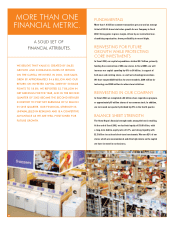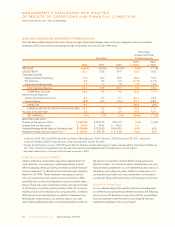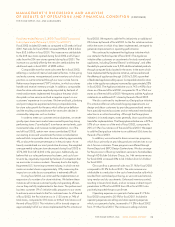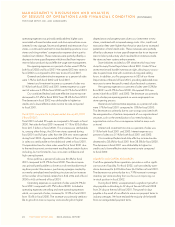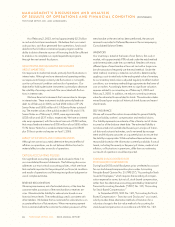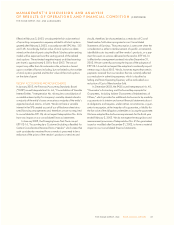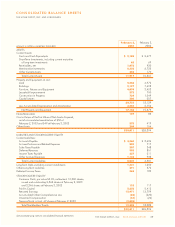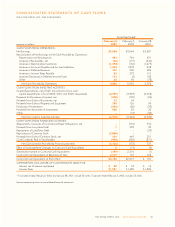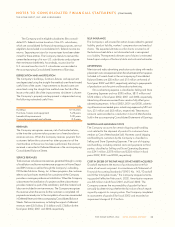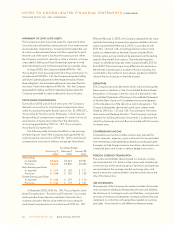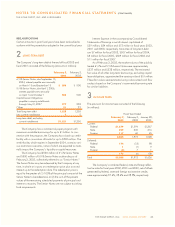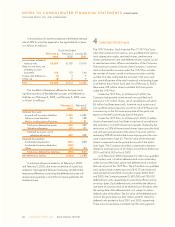Home Depot 2002 Annual Report Download - page 28
Download and view the complete annual report
Please find page 28 of the 2002 Home Depot annual report below. You can navigate through the pages in the report by either clicking on the pages listed below, or by using the keyword search tool below to find specific information within the annual report.
MANAGEMENT’S DISCUSSION AND ANALYSIS
OF RESULTS OF OPERATIONS AND FINANCIAL CONDITION (CONTINUED)
THE HOME DEPOT, INC. AND SUBSIDIARIES
As of February 2, 2003, we had approximately $2.3 billion
in cash and short-term investments. We believe that our current
cash position, cash flow generated from operations, funds avail-
able from the $1 billion commercial paper program and the
ability to obtain alternate sources of financing should be sufficient
to enable us to complete our capital expenditure programs
through the next several fiscal years.
QUANTITATIVE AND QUALITATIVE DISCLOSURES
ABOUT MARKET RISK
Our exposure to market risk results primarily from fluctuations in
interest rates. Although we have international operating entities,
our exposure to foreign currency rate fluctuations is not signifi-
cant to our financial condition and results of operations. Our
objective for holding derivative instruments is primarily to decrease
the volatility of earnings and cash flow associated with fluctua-
tions in interest rates.
We have financial instruments that are sensitive to changes
in interest rates. These instruments include primarily fixed rate
debt. As of February 2, 2003, we had $500 million of 53/8%
Senior Notes and $500 million of 61
/2% Senior Notes outstand-
ing. The market values of the publicly traded 53/8% and 61
/2%
Senior Notes as of February 2, 2003, were approximately
$538 million and $537 million, respectively. We have an interest
rate swap agreement, with the notional amount of $300 million,
that swaps fixed rate interest on $300 million of our $500 million
53/8% Senior Notes for a variable interest rate equal to LIBOR
plus 30 basis points and expires on April 1, 2006.
IMPACT OF INFLATION AND CHANGING PRICES
Although we cannot accurately determine the precise effect of
inflation on operations, we do not believe inflation has had a
material effect on sales or results of operations.
CRITICAL ACCOUNTING POLICIES
Our significant accounting policies are disclosed in Note 1 to
our consolidated financial statements. The following discussion
addresses our most critical accounting policies, which are those
that are both important to the portrayal of our financial condition
and results of operations and that require significant judgment or
use of complex estimates.
REVENUE RECOGNITION
We recognize revenue, net of estimated returns, at the time the
customer takes possession of the merchandise or receives ser-
vices. We estimate the liability for sales returns based on our
historical return levels. The methodology used is consistent with
other retailers. We believe that our estimate for sales returns is an
accurate reflection of future returns. When we receive payment
from customers before the customer has taken possession of the
merchandise or the service has been performed, the amount
received is recorded in Deferred Revenue in the accompanying
Consolidated Balance Sheets.
INVENTORY
Our inventory is stated at the lower of cost (first-in, first-out) or
market, with approximately 93% valued under the retail method
and the remainder under the cost method. Retailers with many
different types of merchandise at low unit cost with a large num-
ber of transactions frequently use the retail method. Under the
retail method, inventory is stated at cost which is determined by
applying a cost-to-retail ratio to the ending retail value of inventory.
As our inventory retail value is adjusted regularly to reflect market
conditions, our inventory methodology approximates the lower of
cost or market. Accordingly, there were no significant valuation
reserves related to our inventory as of February 2, 2003 and
February 3, 2002. In addition, we reduce our ending inventory
value for estimated losses related to shrink. This estimate is deter-
mined based upon analysis of historical shrink losses and recent
shrink trends.
SELF INSURANCE
We are self-insured for certain losses related to general liability,
product liability, workers’ compensation and medical claims.
Our liability represents an estimate of the ultimate cost of claims
incurred as of the balance sheet date. The estimated liability is
not discounted and is established based upon analysis of histori-
cal data and actuarial estimates, and is reviewed by manage-
ment and third party actuaries on a quarterly basis to ensure that
the liability is appropriate. While we believe these estimates are
reasonable based on the information currently available, if actual
trends, including the severity or frequency of claims, medical cost
inflation, or fluctuations in premiums, differ from our estimates,
our results of operations could be impacted.
CHANGE IN ACCOUNTING FOR
STOCK-BASED COMPENSATION
During fiscal 2002 and all fiscal years prior, we elected to account
for our stock-based compensation plans under Accounting
Principles Board Opinion No. 25 (“APB 25”), “Accounting for Stock
Issued to Employees,” which requires the recording of compen-
sation expense for some, but not all, stock-based compensation,
rather than the alternative accounting permitted by Statement of
Financial Accounting Standards (“SFAS”) No. 123, “Accounting
for Stock-Based Compensation.”
In December 2002, SFAS No. 148, “Accounting for Stock-
Based Compensation – Transition and Disclosure,” was issued,
which provides three alternative methods of transition for a
voluntary change to the fair value method of accounting for
stock-based compensation in accordance with SFAS No. 123.
26 THE HOME DEPOT, INC. 2002 ANNUAL REPORT



